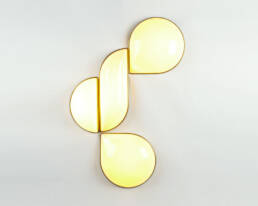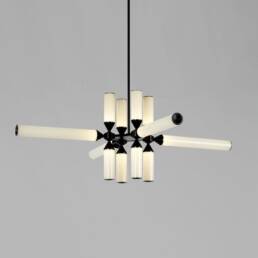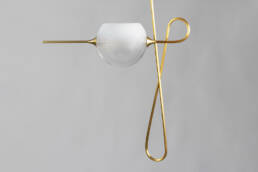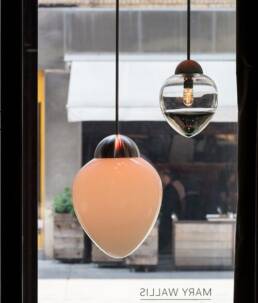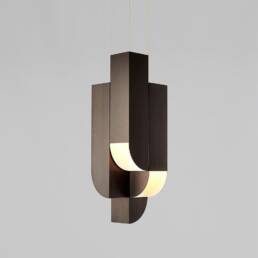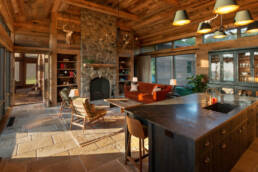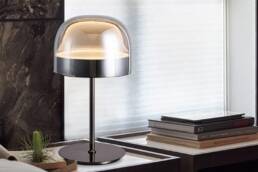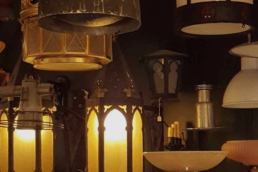The New York Lighting Designer Scene
Lindsey Adelman: Crafting Elegance Through Experimentation
Lindsey Adelman, a contemporary lighting designer based in New York, has garnered attention for her innovative and experimental approach to lighting fixtures. Adelman’s journey into lighting design began when she combined her background in industrial design with her passion for sculpture. This fusion resulted in a unique design philosophy that marries artistic expression with functional lighting.
One of Adelman’s distinctive features is her emphasis on craftsmanship and customization. Her studio produces hand-blown glass fixtures that often evoke a sense of both fragility and strength. The “Branching Bubble” chandelier, one of her iconic creations, exemplifies her signature style. Composed of delicate glass globes arranged organically, this design captures the essence of nature’s asymmetry while maintaining a sense of sophistication.
Adelman’s work embodies experimentation as she frequently collaborates with other artisans, pushing the boundaries of materials and techniques. Her designs tell stories of the creative process, with traces of the human touch evident in every piece. Her influence extends beyond her designs; Adelman has inspired a generation of designers to embrace the marriage of art and function in lighting.
Jason Miller: Striking the Balance Between Tradition and Modernity
Another significant figure in the New York lighting design scene is Jason Miller. His work often bridges the gap between traditional craftsmanship and modern aesthetics. Miller’s approach is characterized by a careful balance between nostalgia and contemporary design sensibilities.
One of Miller’s most renowned works, the “Modo Chandelier,” encapsulates his design philosophy. This chandelier, composed of meticulously arranged glass spheres and metal components, pays homage to both Mid-Century Modern design and the industrial aesthetic. Miller’s ability to reinterpret classic forms in a fresh and relevant manner has earned him a place of prominence in the industry.
Miller’s designs often provoke thought and conversation, challenging preconceived notions of lighting fixtures. His commitment to functional artistry is evident in his pieces, which serve as both practical lighting sources and captivating sculptural installations. Miller’s work highlights the interconnectedness of design history and its ability to shape contemporary creations.
David Weeks: Sculptural Geometry Illuminated
David Weeks, another luminary in the New York lighting design scene, brings a sculptural and geometric dimension to his work. Known for his minimalist yet impactful designs, Weeks creates lighting fixtures that are not only functional but also artistic statements.
Weeks’ designs often revolve around precise geometry and clean lines. His “Hex Pendant,” a striking arrangement of hexagonal wooden panels, showcases his mastery of balancing form and function. Weeks’ background in sculpture is evident as his designs evoke a sense of movement and spatial awareness, casting intriguing shadows and patterns when illuminated.
Beyond his individual creations, Weeks has made contributions to public spaces and collaborative projects. His installations in various venues marry his sculptural approach with architectural contexts, demonstrating his ability to enhance environments through lighting. Weeks’ work stands as a testament to the power of geometry in design, reminding us that simplicity can be remarkably impactful.
The New York Lighting Design Scene: A Tapestry of Innovation
Beyond these individual designers, the New York lighting design scene as a whole has been a thriving hub of innovation and creativity. The city’s diverse artistic landscape, coupled with its rich history of design and architecture, provides a fertile ground for designers to explore new frontiers.
The New York design scene’s dynamism is exemplified through events like the International Contemporary Furniture Fair (ICFF) and the New York Design Week, where lighting designers showcase their latest creations. These platforms not only spotlight established designers but also provide emerging talents with opportunities to gain recognition.
Moreover, the emphasis on sustainability and technological advancement within the field has prompted New York lighting designers to incorporate energy-efficient materials and smart technologies into their creations. This integration of sustainability and innovation reflects the city’s commitment to responsible design practices.
In conclusion, the New York lighting design scene has been significantly enriched by the contributions of designers like Lindsey Adelman, Jason Miller, and David Weeks. Their unique perspectives, coupled with their commitment to pushing artistic boundaries, have elevated lighting fixtures from mere functional objects to captivating works of art. As the city continues to evolve as a design powerhouse, one can only anticipate the ongoing brilliance that will illuminate from this vibrant community of designers.
Exploring the Brilliance of New York Lighting Designers: Karl Zahn, Mary Wallis, Bec Brittain, Gabriel Hendifar, and Jeremy Anderson
The world of lighting design in New York City is a vibrant tapestry woven with creativity, innovation, and a deep understanding of form and function. Within this bustling metropolis, several designers have risen to prominence, each leaving an indelible mark on the landscape of lighting design. This essay delves into the unique contributions of Karl Zahn, Mary Wallis, Bec Brittain, Gabriel Hendifar, and Jeremy Anderson – all influential figures shaping the contemporary lighting design scene in New York.
Karl Zahn: Nature-Inspired Elegance
Karl Zahn, a New York-based designer, draws inspiration from nature’s intricate beauty. His work often reflects a harmonious blend of organic forms and modern design sensibilities. Zahn’s approach can be described as both playful and sophisticated, with a keen focus on materials and their inherent qualities.
Zahn’s “Branch Light” is a prime example of his design philosophy. This pendant light takes inspiration from branches found in the natural world, featuring an elegant, minimalistic structure. By employing sustainable materials and masterful craftsmanship, Zahn elevates the ordinary into the extraordinary, turning a simple branch into a functional work of art.
Mary Wallis: Sculptural Whimsy
Mary Wallis’s lighting designs offer a fresh perspective through whimsical and sculptural creations. Her work often challenges conventions and blurs the lines between art and functional design. Wallis’s approach celebrates the playfulness of design, as seen in her “Magnetism” series, where magnetic forces seemingly suspend illuminated elements in mid-air.
By infusing her designs with a sense of wonder and delight, Wallis invites viewers to engage with her creations on a deeper level. Her work encourages us to question preconceived notions about lighting and allows us to experience the joy of interactive design.
Bec Brittain: Geometry and Illumination
Bec Brittain is renowned for her geometric explorations in lighting design. Her pieces often feature clean lines, intricate patterns, and an interplay of light and shadow. Brittain’s designs are a testament to the beauty of precision and the artistry of symmetry.
The “Shy Light” is a quintessential example of Brittain’s work. Comprising a series of delicate, interconnected LED tubes, this design showcases her mastery in creating dynamic visual experiences through geometric forms. Brittain’s work seamlessly merges mathematics, aesthetics, and illumination, resulting in fixtures that captivate and intrigue.
Gabriel Hendifar: Artful Exuberance
Gabriel Hendifar, co-founder of Apparatus Studio, brings a sense of exuberance and artistry to lighting design. His creations often embody a blend of luxury, craftsmanship, and theatricality. Hendifar’s designs are characterized by their sculptural presence, combining elements like brass, glass, and leather to create sumptuous lighting fixtures.
The “Cloud” chandelier, an iconic design by Apparatus Studio, exemplifies Hendifar’s penchant for drama and sophistication. Composed of porcelain flowers and illuminated from within, the fixture evokes a sense of ethereal beauty and opulence. Hendifar’s work showcases how lighting design can transcend functionality and become an integral part of interior aesthetics.
Jeremy Anderson: Material Alchemy
Jeremy Anderson’s lighting designs push the boundaries of materiality and transformation. Anderson’s work often involves experimenting with unconventional materials, resulting in designs that challenge our perception of what lighting fixtures can be. His approach can be described as alchemical, as he transforms raw materials into radiant, captivating pieces.
The “Crystalline” series by Anderson exemplifies his innovative approach. By combining resin and LED technology, he creates fixtures that emit a warm, otherworldly glow. Anderson’s work underscores the transformative power of design, as he turns materials into sources of illumination and wonder.
A Dynamic Landscape of Design
The New York lighting design scene is a dynamic landscape enriched by the creativity of designers like Karl Zahn, Mary Wallis, Bec Brittain, Gabriel Hendifar, and Jeremy Anderson. Their distinctive visions and innovative approaches contribute to the city’s reputation as a hub for artistic expression and cutting-edge design. As these designers continue to explore new materials, reimagine forms, and challenge conventions, the world can anticipate an ongoing evolution of lighting design that illuminates spaces and sparks imaginations.



